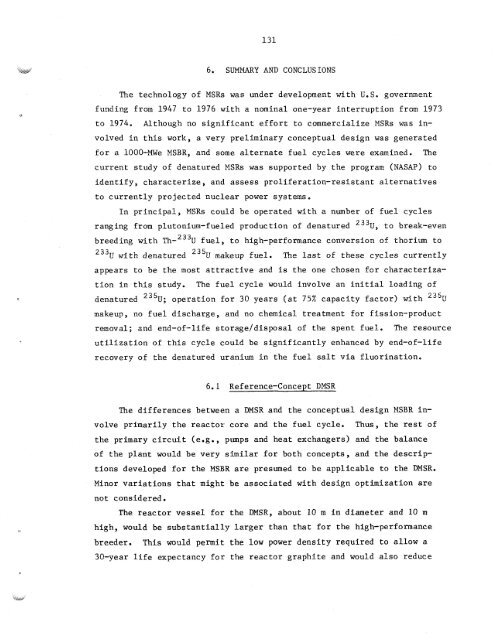ORNL-TM-7207 - the Molten Salt Energy Technologies Web Site
ORNL-TM-7207 - the Molten Salt Energy Technologies Web Site
ORNL-TM-7207 - the Molten Salt Energy Technologies Web Site
Create successful ePaper yourself
Turn your PDF publications into a flip-book with our unique Google optimized e-Paper software.
. ~.........* . . . . . :*.<br />
... . -,p<br />
, . . . . . .<br />
*.!,A<br />
me technology of<br />
131<br />
6, SUMMARY AND CONCLUSIONS<br />
MSRs was under development with U.S. gsverment<br />
funding from 1947 to 1976 with a nominal one-year interruption from 11993<br />
to 1974.<br />
Although no significant effort to commercialize MSRs was in-<br />
volved in this work, a very preliminary conceptual design was generated<br />
for it 10QO-We MSBR, and some alternate fuel cycles were examined. The<br />
current study of denatured PIS& was supported by <strong>the</strong> program (NASAP) to<br />
identify, characterize, and assess pso8igeration-resistant alternatives<br />
to currently projected nuclear power systems.<br />
In principal, MSRs could be operated with a number of fuel cycles<br />
ranging from plutonium-fueled proc~uction of denatured 2 "u, to break-even<br />
breeding with fuel, to high-performance conversion of rhorim to<br />
2 3 3 ~ with denatured 2 3 5 ~ makeup fuel. me last of <strong>the</strong>se cycles currently<br />
appears to be <strong>the</strong> most attractive and is <strong>the</strong> one chosen for characteriza-<br />
tion in this study. The fuel cycle would involve an initial loading of<br />
denatured 235~; operation for ~ Cyears I (at 75% capacity factor) with 2 3 5 ~<br />
makeup, mo fuel discharge, and no chemical treatment for fission-product<br />
removal; and end-of-life storageBdisposa1 of <strong>the</strong> spent fuel. me resource<br />
utilization of this cycle could be significantly enhanced by end-of-life<br />
recovery of <strong>the</strong> denatured uranium in <strong>the</strong> fuel salt via fluorination.<br />
6.1 Reference-Concept DMSR<br />
The differences between a DMSR and <strong>the</strong> conceptual design MSBR in-<br />
volve primarily <strong>the</strong> reactor core and <strong>the</strong> fuel cycle. Thus, <strong>the</strong> rest of<br />
<strong>the</strong> primary circuit (e.g., pumps and heat exchangers) and <strong>the</strong> balance<br />
of <strong>the</strong> plant would be very similar for both concepts, and <strong>the</strong> descrip-<br />
tions developed for <strong>the</strong> MSBR are presumed to be applicable to <strong>the</strong> DMSB.<br />
Minor variatio~s that wight be associated with design optimization are<br />
not considered.<br />
The reactor vessel for <strong>the</strong> DMSR, about 18 m in diameter and 10 m<br />
high, would be substantially larger than that for <strong>the</strong> high-performance<br />
breeder.<br />
This would permit <strong>the</strong> Pow power density required to allow a<br />
38-year life expectancy for <strong>the</strong> reactor graphite and would also reduce



![Review of Molten Salt Reactor Physics Calculations [Disc 2]](https://img.yumpu.com/21979492/1/190x247/review-of-molten-salt-reactor-physics-calculations-disc-2.jpg?quality=85)












